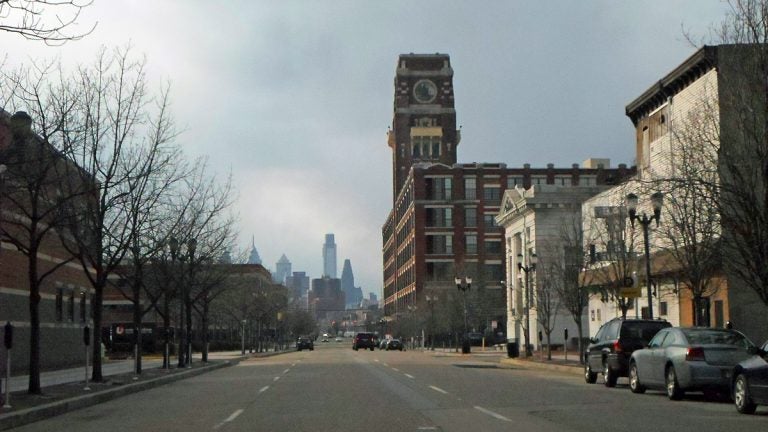‘Manhattanizing’ Philadelphia could help make Camden the next Brooklyn

Looking west on Market Street in Camden. Beyond is Philadelphia's Center City. (Alan Tu/WHYY)
Could it simply be a coincidence? Hard on the exciting news that celebrity Iron Chef Jose Garces will soon be serving exquisite dinners priced between $150 and $250 a person pre-performance at the Kimmel Center, we learn of a new tower apartment complex overlooking historic Independence Hall.
For those unlucky enough not to grab a multi-million dollar condo on Rittenhouse Square, developer Tom Scannapieco is offering a second chance at 5th and Walnut. Prices for the 40 new units aren’t public, but Scannapieco’s research assures him that among the 2,000 people in the Philadelphia metropolitan area worth more than $10 million, there are bound to be enough customers to fill the new structure. Certainly, he thinks, the city’s 10-year tax abatement program offers “a very valuable incentive.”
Philadelphia doesn’t project the image of “super luxury” easily. That Quaker frugality so firmly associated with the city may be a thing of the past, but surely these new efforts to cater to the super wealthy must mean something.
Sharing the vision
Some years ago, when he was serving as Philadelphia’s mayor, Ed Rendell made an appearance across the river in an effort to boost the prospects of Camden’s new mayor, Milton Milan, the first Hispanic to head the troubled city of Camden. Do as we do, Rendell suggested: make downtown appeal to empty nesters. Once they relocate from the suburbs, commerce downtown will thrive.
Milan’s declaration that Camden was “open for business” proved not exactly what Rendell had in mind when Milan was caught taking bribes and found his way to prison before completing his first term in office. In fact, most of those in Rendell’s audience that day laughed at the prospect of attracting upscale buyers to Camden’s downtown. Rendell may simply have been ahead of his time.
No doubt, tax incentives combined with a burgeoning move toward downsizing family suburban homes among baby boomers contributed to the rising fortunes of Center City. It didn’t hurt either that a positive attitude towards cities among young people their children’s ages added to the revitalization of Central City and adjacent neighborhoods like Northern Liberties and parts of South Philadelphia.
Priced out of Philly
If Tom Scannapieco’s initiative proves a harbinger, however, parts of downtown will price many potential middle income residents out of the market. In that case, one can imagine a pattern suggested by Mr. Rendell back in the 1990s when he pointed to housing markets in cities like Hoboken and Jersey City that were benefiting from the flight of potential residents from an overheated real estate market in Manhattan.
When the bridge connecting Camden and Philadelphia opened in 1926, boosters envisioned Camden as the new Brooklyn. Through traffic over the bridge ended up undermining Camden rather than boosting its fortunes as anticipated. But now that Philadelphia seems to be moving in the direction of Manhattan, there is a chance that Camden can belatedly achieve the status, like Brooklyn, of a destination for potential residents priced out of the downtown.
Before the recession, both Camden and the State of New Jersey were thinking in just this way. Carl Dranoff’s highly successful conversion of one of RCA’s few remaining industrial structures into the Victor Lofts showed the way. The city has been waiting now for years for Dranoff’s next conversion of another RCA building into condominiums.
Further market-rate housing has been anticipated on Camden’s waterfront between Adventure Aquarium and Campbell Field as part of the deal that privatized the aquarium and aided its expansion.
A rebalancing of the distribution of regional wealth back towards cities can be embraced as a good thing. The loss of industries in Philadelphia and Camden hollowed out much of these areas and crippled their tax bases.
Certainly new, high-end investment is not the only or even the most desirable route to revitalization, but it is part of the equation. Camden officials would do well to take note and to reactivate those plans for waterfront construction that have been shelved for the duration of the recession.
The process is bound to be slow in Camden. You’ll know when it has worked, however, when Jose Garces announces he has decided to open a branch of his Kimmel-based restraunt at Rutgers-Camden’s Gordon Theater.
_________________________________________
Howard Gillette is author of Camden After the Fall: Decline and Renewal in a Post-Industrial City and is professor of history emeritus at Rutgers Camden.
WHYY is your source for fact-based, in-depth journalism and information. As a nonprofit organization, we rely on financial support from readers like you. Please give today.

